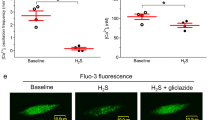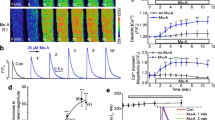Abstract
Intracellular Са2+ controls its own level by regulation of Ca2+ transport across the plasma and organellar membranes, often acting via calmodulin (CaM). Drugs antagonizing CaM action induce an increase in cytosolic Ca2+ concentration in different cells. We have found persistent Са2+ oscillations in cultured white adipocytes in response to calmidazolium (CMZ). They appeared at [CMZ] > 1 μM as repetitive sharp spikes mainly superimposed on a transient or elevated baseline. Similar oscillations were observed when we used trifluoperazine. Oscillations evoked by 5 μM CMZ resulted from the release of stored Ca2+ and were supported by Са2+ entry. Inhibition of store-operated channels by YM-58483 or 2-APB did not change the responses. Phospholipase A2 inhibited by AACOCF3 was responsible for initial Ca2+ mobilization, but not for subsequent oscillations, whereas inhibition of iPLA2 by BEL had no effect. Phospholipase C was partially involved in both stages as revealed with U73122. Intracellular Са2+ stores engaged by CMZ were entirely dependent on thapsigargin. The oscillations existed in the presence of inhibitors of ryanodine or inositol 1,4,5-trisphosphate receptors, or antagonists of Ca2+ transport by lysosome-like acidic stores. Carbenoxolone or octanol, blockers of hemichannels (connexons), when applied for two hours, prevented oscillations but did not affect the initial Са2+ release. Incubation with La3+ for 2 or 24 h inhibited all responses to CMZ, retaining the thapsigargin-induced Ca2+ rise. These results suggest that Ca2+-CaM regulation suppresses La3+-sensitive channels in non-acidic organelles, of which arachidonate-activated channels initiate Ca2+ oscillations, and connexons are intimately implicated in their generation mechanism.








Similar content being viewed by others
References
Carafoli E, Santella L, Brance D, Brini M (2001) Generation, control, and processing of cellular calcium signals. Crit Rev Biochem Mol Biol 36:107–260
Berridge MJ (2012) Calcium signalling remodelling and disease. Biochem Soc Trans 40:297–309
Berchtold MW, Villalobo A (2014) The many faces of calmodulin in cell proliferation, programmed cell death, autophagy, and cancer. Biochim Biophys Acta 1843:398–435
Uhlén P, Fritz N (2010) Biochemistry of calcium oscillations. Biochem Biophys Res Commun 396:28–32
Trebak M, Putney JW Jr (2017) ORAI calcium channels. Physiology (Bethesda) 32:332–342
Shuttleworth TJ (1999) What drives calcium entry during [Ca2+]i oscillations?—challenging the capacitative model. Cell Calcium 25:237–246
Kawano S, Otsu K, Kuruma A, Shoji S, Yanagida E, Muto Y, Yoshikawa F, Hirayama Y, Mikoshiba K, Furuichi T (2006) ATP autocrine/paracrine signaling induces calcium oscillations and NFAT activation in human mesenchymal stem cells. Cell Calcium 39:313–324
De Bock M, Wang N, Bol M, Decrock E, Ponsaerts R, Bultynck G, Dupont G, Leybaert L (2012) Connexin 43 hemichannels contribute to cytoplasmic Ca2+ oscillations by providing a bimodal Ca2+-dependent Ca2+ entry pathway. J Biol Chem 287:12250–12266
Bol M, Wang N, De Bock M, Wacquier B, Decrock E, Gadicherla A, Decaluwé K, Vanheel B, van Rijen HV, Krysko DV, Bultynck G, Dupont G, Van de Voorde J, Leybaert L (2017) At the cross-point of connexins, calcium, and ATP: blocking hemichannels inhibits vasoconstriction of rat small mesenteric arteries. Cardiovasc Res 113:195–206
Leybaert L, Lampe PD, Dhein S, Kwak BR, Ferdinandy P, Beyer EC, Laird DW, Naus CC, Green CR, Schulz R (2017) Connexins in cardiovascular and neurovascular health and disease: pharmacological implications. Pharmacol Rev 69:396–478
Laird DW (2006) Life cycle of connexins in health and disease. Biochem J 394:527–543
Bruzzone S, Guida L, Sturla L, Usai C, Zocchi E, De Flora A (2012) Subcellular and intercellular traffic of NAD+, NAD+ precursors and NAD+-derived signal metabolites and second messengers: old and new topological paradoxes. Messenger 1:34–52. https://doi.org/10.1166/msr.2012.1007
D’hondt C, Ponsaerts R, De Smedt H, Bultynck G, Himpens B (2009) Pannexins, distant relatives of the connexin family with specific cellular functions? Bioessays 31:953–974
Morgan AJ, Platt FM, Lloyd-Evans E, Galione A (2011) Molecular mechanisms of endolysosomal Ca2+ signalling in health and disease. Biochem J 439:349–374
Tornquist K, Ekokoski E (1996) Inhibition of agonist-mediated calcium entry by calmodulin antagonists and by the Ca2+/calmodulin kinase II inhibitor KN-62. Studies with thyroid FRTL-5 cells. J Endocrinol 148:131–138
Watanabe H, Takahashi R, Tran QK, Takeuchi K, Kosuge K, Satoh H, Uehara A, Terada H, Hayashi H, Ohno R, Ohashi K (1999) Increased cytosolic Ca2+ concentration in endothelial cells by calmodulin antagonists. Biochem Biophys Res Commun 265:697–702
Harper JL, Daly JW (2000) Effect of calmidazolium analogs on calcium influx in HL-60 cells. Biochem Pharmacol 60:317–324
Jan CR, Tseng CJ (2000) Calmidazolium-induced rises in cytosolic calcium concentrations in Madin-Darby canine kidney cells. Toxicol Appl Pharmacol 162:142–150
Smani T, Zakharov SI, Csutora P, Leno E, Trepakova ES, Bolotina VM (2004) A novel mechanism for the store-operated calcium influx pathway. Nat Cell Biol 6:113–120
Peppiatt CM, Holmes AM, Seo JT, Bootman MD, Collins TJ, McDonald F, Roderick HL (2004) Calmidazolium and arachidonate activate a calcium entry pathway that is distinct from store-operated calcium influx in HeLa cells. Biochem J 381:929–939
Zinchenko VP, Kasymov VA, Li VV, Kaimachnikov NP (2005) The calmodulin inhibitor R24571 induces a short-term Ca2+ entry and a pulse-like secretion of ATP in Ehrlich ascites tumor cells. Biofizika 50:1055–1069
Liao WC, Huang CC, Cheng HH, Wang JL, Lin KL, Cheng JS, Chai KL, Hsu PT, Tsai JY, Fang YC, Lu YC, Chang HT, Huang JK, Chou CT, Jan CR (2009) Effect of calmidazolium on [Ca2+]i and viability in human hepatoma cells. Arch Toxicol 83:61–68
Somogyi R, Stucki JW (1991) Hormone-induced calcium oscillations in liver cells can be explained by a simple one pool model. J Biol Chem 266:11068–11077
Uneyama H, Uneyama C, Akaike N (1993) Intracellular mechanisms of cytoplasmic Ca2+ oscillation in rat megakaryocyte. J Biol Chem 268:168–174
Turovsky EA, Kaimachnikov NP, Zinchenko VP (2014) Agonist-specific participation of SOC and ARC channels and iPLA2 in the regulation of Ca2+ entry during oscillatory responses in adipocytes. Biochem (Moscow) Suppl Ser A: Membr Cell Biol 8:136–143. https://doi.org/10.1134/S1990747813050206
Veigl ML, Klevit RE, Sedwick WD (1989) The uses and limitations of calmodulin antagonists. Pharmacol Ther 44:181–239
Turovsky EA, Kaimachnikov NP, Turovskaya MV, Berezhnov AV, Dynnik VV, Zinchenko VP (2012) Two mechanisms of calcium oscillations in adipocytes. Biochem (Moscow) Suppl Ser A: Membr Cell Biol 6:26–34. https://doi.org/10.1134/S199074781106016X
Dolgacheva LP, Turovskaya MV, Dynnik VV, Zinchenko VP, Goncharov NV, Davletov B, Turovsky EA (2016) Angiotensin II activates different calcium signaling pathways in adipocytes. Arch Biochem Biophys 593:38–49
Bogan SJ (2012) Regulation of glucose transporter translocation in health and diabetes. Annu Rev Biochem 81:507–532
Park KH, Kim BJ, Shawl AI, Han MK, Lee HC, Kim UH (2013) Autocrine/paracrine function of nicotinic acid adenine dinucleotide phosphate (NAADP) for glucose homeostasis in pancreatic β-cells and adipocytes. J Biol Chem 288:35548–35558
Zitt C, Strauss B, Schwarz EC, Spaeth N, Rast G, Hatzelmann A, Hoth M (2004) Potent inhibition of Ca2+ release-activated Ca2+ channels and T-lymphocyte activation by the pyrazole derivative BTP2. J Biol Chem 279:12427–12437
Putney JW (2010) Pharmacology of store-operated calcium channels. Mol Interv 10:209–218
Ackermann EJ, Conde-Frieboes K, Dennis EA (1995) Inhibition of macrophage Ca2+-independent phospholipase A2 by bromoenol lactone and trifluoromethyl ketones. J Biol Chem 270:445–450
Duncan RE, Sarkadi-Nagy E, Jaworski K, Ahmadian M, Sul HS (2008) Identification and functional characterization of adipose-specific phospholipase A2 (AdPLA). J Biol Chem 283:25428–25436
Jaworski K, Ahmadian M, Duncan RE, Sarkadi-Nagy E, Varady KA, Hellerstein MK, Lee HY, Samuel VT, Shulman GI, Kim KH, de Val S, Kang C, Sul HS (2009) AdPLA ablation increases lipolysis and prevents obesity induced by high-fat feeding or leptin deficiency. Nat Med 15:159–168
Broad LM, Cannon TR, Taylor CW (1999) A non-capacitative pathway activated by arachidonic acid is the major Ca2+ entry mechanism in rat A7r5 smooth muscle cells stimulated with low concentrations of vasopressin. J Physiol 517:121–134
Zimányi I, Buck E, Abramson JJ, Mack MM, Pessah IN (1992) Ryanodine induces persistent inactivation of the Ca2+ release channel from skeletal muscle sarcoplasmic reticulum. Mol Pharmacol 42:1049–1057
Gafni J, Munsch JA, Lam TH, Catlin MC, Costa LG, Molinski TF, Pessah IN (1997) Xestospongins: potent membrane permeable blockers of the inositol 1,4,5-trisphosphate receptor. Neuron 19:723–733
Castonguay A, Robitaille R (2002) Xestospongin C is a potent inhibitor of SERCA at a vertebrate synapse. Cell Calcium 32:39–47
Mignen O, Thompson JL, Shuttleworth TJ (2003) Ca2+ selectivity and fatty acid specificity of the noncapacitative, arachidonate-regulated Ca2+ (ARC) channels. J Biol Chem 278:10174–10181
Naylor E, Arredouani A, Vasudevan SR, Lewis AM, Parkesh R, Mizote A, Rosen D, Thomas JM, Izumi M, Ganesan A, Galione A, Churchill GC (2009) Identification of a chemical probe for NAADP by virtual screening. Nat Chem Biol 5:220–226
Lee H, Jun DJ, Suh BC, Choi BH, Lee JH, Do MS, Suh BS, Ha H, Kim KT (2005) Dual roles of P2 purinergic receptors in insulin-stimulated leptin production and lipolysis in differentiated rat white adipocytes. J Biol Chem 280:28556–28563
Mignen O, Shuttleworth TJ (2000) IARC, a novel arachidonate-regulated, noncapacitative Ca2+ entry channel. J Biol Chem 275:9114–9119
John SA, Kondo R, Wang SY, Goldhaber JI, Weiss JN (1999) Connexin-43 hemichannels opened by metabolic inhibition. J Biol Chem 274:236–240
Kwan CY, Putney JW Jr (1990) Uptake and intracellular sequestration of divalent cations in resting and methacholine-stimulated mouse lacrimal acinar cells. Dissociation by Sr2+ and Ba2+ of agonist-stimulated divalent cation entry from the refilling of the agonist-sensitive intracellular pool. J Biol Chem 265:678–684
Sorkin A, von Zastrow M (2002) Signal transduction and endocytosis: close encounters of many kinds. Nat Rev Mol Cell Biol 3:600–614
Weigel PH, Oka JA (1981) Temperature dependence of endocytosis mediated by the asialoglycoprotein receptor in isolated rat hepatocytes. Evidence for two potentially rate-limiting steps. J Biol Chem 256:2615–2617
Holmes AM, Roderick HL, McDonald F, Bootman MD (2007) Interaction between store-operated and arachidonate-activated calcium entry. Cell Calcium 41:1–12
He LP, Hewavitharana T, Soboloff J, Spassova MA, Gill DL (2005) A functional link between store-operated and TRPC channels revealed by the 3,5-bis(trifluoromethyl)pyrazole derivative, BTP2. J Biol Chem 280:10997–11006
Bodendiek SB, Raman G (2010) Connexin modulators and their potential targets under the magnifying glass. Curr Med Chem 17:4191–4230
Beauvois MC, Arredouani A, Jonas JC, Rolland JF, Schuit F, Henquin JC, Gilon P (2004) Atypical Ca2+-induced Ca2+ release from a sarco-endoplasmic reticulum Ca2+-ATPase 3-dependent Ca2+ pool in mouse pancreatic beta-cells. J Physiol 559:141–156
Yu F, Sun L, Machaca K (2010) Constitutive recycling of the store-operated Ca2+ channel Orai1 and its internalization during meiosis. J Cell Biol 191:523–535
Tang Y, Stephenson JL, Othmer HG (1996) Simplification and analysis of models of calcium dynamics based on IP3-sensitive calcium channel kinetics. Biophys J 70:246–263
Pizzo P, Lissandron V, Capitanio P, Pozzan T (2011) Ca2+ signalling in the Golgi apparatus. Cell Calcium 50:184–192
Huotari J, Helenius A (2011) Endosome maturation. EMBO J 30:3481–3500
Gerasimenko JV, Tepikin AV, Petersen OH, Gerasimenko OV (1998) Calcium uptake via endocytosis with rapid release from acidifying endosomes. Curr Biol 8:1335–1338
Choi YO, Park JH, Song YS, Lee W, Moriyama Y, Choe H, Leem CH, Jang YJ (2007) Involvement of vesicular H+-ATPase in insulin-stimulated glucose transport in 3T3-F442A adipocytes. Endocr J 54:733–743
Khan SZ, Longland CL, Michelangeli F (2000) The effects of phenothiazines and other calmodulin antagonists on the sarcoplasmic and endoplasmic reticulum Ca2+ pumps. Biochem Pharmacol 60:1797–1806
Acknowledgements
This work was supported by a Grant of the President of the Russian Federation (Ref: МК-626.2018.4, EAT).
Author information
Authors and Affiliations
Contributions
EAT performed all experiments, contributed to the experimental design and data analysis and prepared figures. VPZ contributed reagents and materials, participated in the discussion of results, and edited the manuscript. NPK conceived the study, designed the experiments, analyzed and interpreted the data, and wrote the manuscript.
Corresponding author
Ethics declarations
Conflict of interest
The authors state that they have no conflict of interest pertaining to this manuscript.
Additional information
Publisher’s Note
Springer Nature remains neutral with regard to jurisdictional claims in published maps and institutional affiliations.
Rights and permissions
About this article
Cite this article
Turovsky, E.A., Zinchenko, V.P. & Kaimachnikov, N.P. Attenuation of calmodulin regulation evokes Ca2+ oscillations: evidence for the involvement of intracellular arachidonate-activated channels and connexons. Mol Cell Biochem 456, 191–204 (2019). https://doi.org/10.1007/s11010-019-03504-z
Received:
Accepted:
Published:
Issue Date:
DOI: https://doi.org/10.1007/s11010-019-03504-z




